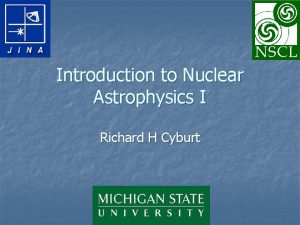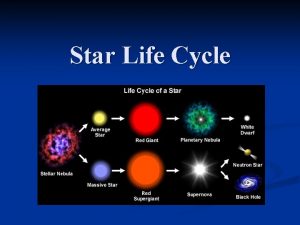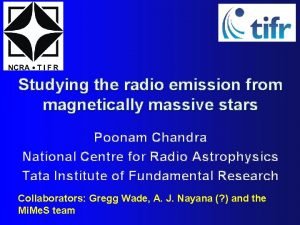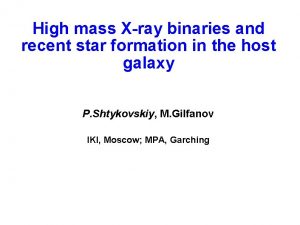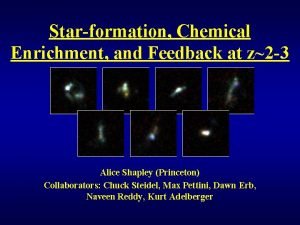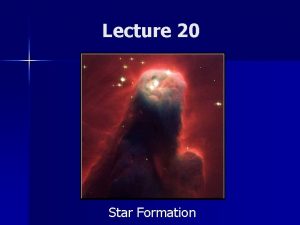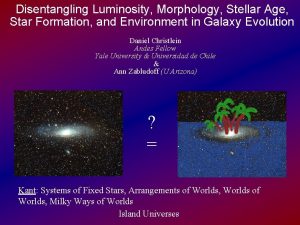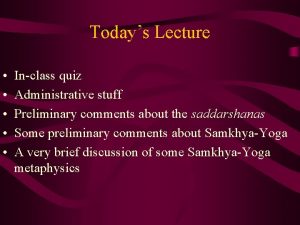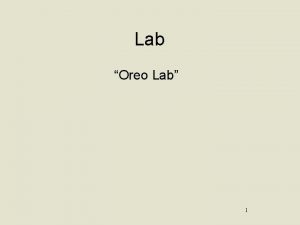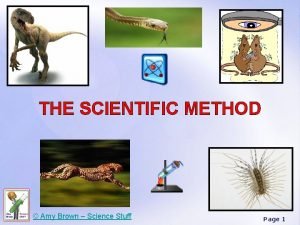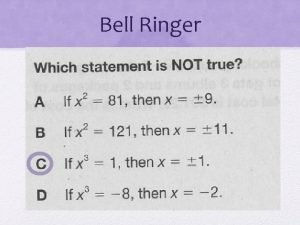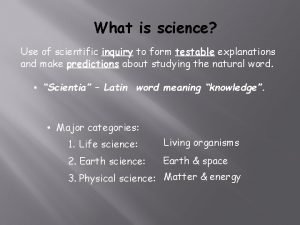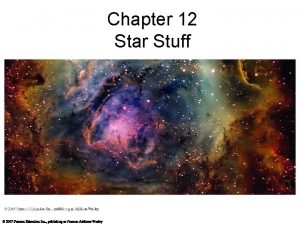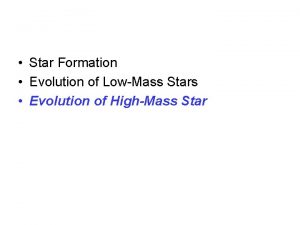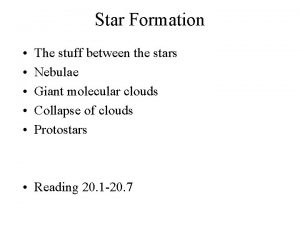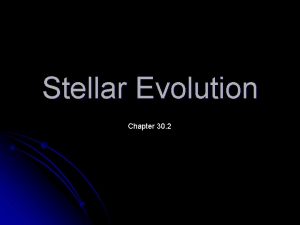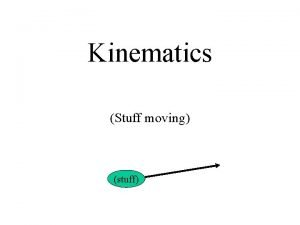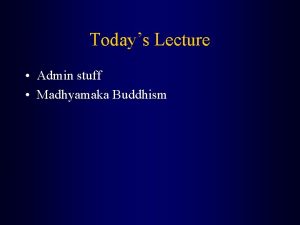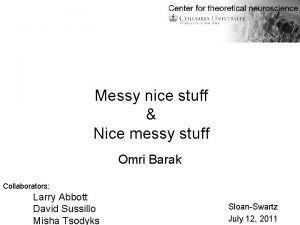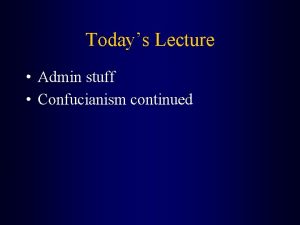Chapter 14 Star Stuff Star Formation Evolution of
































- Slides: 32

Chapter 14: Star Stuff Star Formation Evolution of Low-Mass Stars Evolution of High-Mass Stars Evolution of Close Binary Stars

14. 1 Lives in the Balance • Story of a star’s life: Battle between gravity and pressure. • A star needs thermal pressure to balance gravity. • Sources of pressure: nuclear fusion or contraction. • The evolution of a star depends almost entirely on its birth mass. • We start looking at the process of stellar birth.

14. 2 Star Birth • Star-forming clouds are cold (10 -30 K) and dense. They are called molecular clouds because their low temperatures allow the formation of H 2 and other molecules such as CO, H 2 O and dust. • The cold temperatures and high density allow gravity to overcome thermal pressure, initiating the collapse toward new stars.

Protostars (earliest form of stars) • Contraction increases the cloud’s thermal energy, which is initially radiated away quickly. • When thermal energy cannot longer escape easily, the internal temperature and pressure rise dramatically. • Dense cloud fragments become protostars.

Protostellar Disk • The law of conservation of angular momentum (=m x v x r) implies that cloud fragments spin faster as they collapse. • As it shrinks, a rotating cloud must flatten to form a protostellar disk. • Are all protostellar disks also protoplanetary disks?

Protostellar Wind • Rapid rotation generates a strong magnetic field. • Angular momentum can be trasferred outward along magnetic field lines. • An outward flow of particles similar to the solar wind, constitutes the protostellar wind. • Many young stars fire high -speed collimated jets. • H-H objects are shock fronts of jets with the ISM

A Star Is Born • In HRD we can plot evolutionary tracks for newborn stars. • Young stars contract until their cores become hot enough for H fusion (10 million K). • The pre-main-sequence lifetime depends on the star’s mass. For 1 MSun it lasts about 50 million years.

PMS Evolution • T Tauri stars, named after variable star T in Taurus are PMS stars that have just emerged from their cocoons. They have accretion disks and strong magnetic fields. • They occur in young star clusters and loose T associations. • Post T Tauri stars are intermediate between T Tauris and MS stars.

The Initial Mass Function • Molecular clouds collapse and fragment leading to stars with a wide array of masses. • Stars with low masses greatly outnumber stars with high masses. • For every star with mass 10 -100 MSun, there are ~10 stars with 2 -10 MSun, 50 with 0. 5 -2 MSun and few 100 s with mass <0. 5 MSun.

Limits to Stellar Masses • Above ~100 MSun gravity cannot contain the radiation pressure. • Below 0. 08 MSun the central temperature never climbs sufficiently for stable H-burning. Degeneracy pressure halts gravitational contraction.

Substellar Objects • Pauli’s exclusion principle prevents two identical efrom occupying the same space at the same time. • The resistance to squeezing exerts a deneracy pressure that halts contraction. This pressure does not depend on temperature, only on density. • Brown dwarfs and giant planets.

14. 3 Evolution of Low-Mass Stars. • Lower-mass stars have cooler interiors and deeper convection zones. • In very low-mass stars and brown dwarfs, the convection zone extends all the way down to the core.

Moving Away from the Main Sequence • When the central supply of H is depleted, the core shrinks and outer layers expand. • For 1 MSun, the evolution away from the MS, through the subgiant phase and into the red giant branch takes about 1 billion years.

Hydrogen Shell Burning • The He core is inert. • Gravity shrinks a shell of H around the core and allows it to burn. • The temperature is higher, the H burns faster than in the MS, the star expands and becomes more luminous. Slow winds carry away matter. • Newly produced He amplifies core shrinking.

Helium Burning • He nuclei have two p and hence 2 x positive charge than H. • He fusion occurs at higher temperature than H fusion. Tburn(He)~108 K • A 12 C nucleus has slightly less mass than 3 4 He nuclei.

Structure of He Burning Stars • He ignites very suddently (He flash), pushing the H-burning shell away, and lowering the temperature. • The He-burning star becomes hotter and smaller than a red giant.

Horizontal Branch • In a stellar cluster, the He-burning stars are arranged along a horizontal branch. • The He cores of all low-mass stars fuse He at about the same rate, so they have about the same luminosity.

Final Stages of Evolution • Core runs out of He in about 108 years. • Core shrinks and He burns in a shell around it. Star expands again. • Carbon fusion requires Tcore~6 x 108 K. Low-mass stars develop degenerate cores before reaching such temperature.

Carbon Stars • Strong convection can dredge up C from the core to the surface. • Carbon-rich red giants are called carbon stars. They have cool, slow winds where insterstellar dust grains condensate. • Carbon stars are the largest dust polluters in the universe.

Planetary Nebulae • When the inert core becomes degenerate, a low -mass star ejects its outer layers into space. • A planetary nebula is an expanding shell that glows brightly because it is heated by the UV radiation emitted by the exposed C-He core. A PN lasts only ~ 106 years.

Evolution of High-Mass Stars • The hot core temperatures of high-mass stars enable a higher rate of H fusion. • C, N, O atoms act as catalysts of a reaction chain called CNO cycle, which is a more efficient way of fusing H into He than the pp chain. • Radiation pressure can drive strong, fastmoving winds.

Onion Structure • Chain of events: H-core exhaustion; H-shell burning; Gradual He fusion; He-shell fusion; C-shell burning; Ofusion; O-shell burning; Ne -fusion; Ne-shell burning; Mg-fusion; Mg-shell burning; Si-fusion; Sishell burning. • Layer upon layer of shells burning different elements with inert Fe core.

Life Tracks of High-Mass Stars • High-mass stars zigzag across the HRD. • Each time a fuel is exhausted in the core, shell burning makes the star expand. • At each stage of core fusion of a heavier element, the outer layers contract and the star’s surface temperature increases.

The Iron Wall • Iron is the only one element from which it is not possible to generate any kind of nuclear energy. • Iron has the lowest mass per nuclear particle of all nuclei. It cannot release energy by either fusion or fission. It is the most stable element in the universe.

Massive Star’s Final Collapse • Electron degeneracy cannot support the structure of stars with M>8 MSun. • Electrons combine with protons producing neutrons and neutrinos. • About 1 MSun of Fe in the core with a size ~1 REarth collapses into a neutron corpse with size ~Honolulu. • Neutron degeneracy halts further collapse.

Supernova Explosion!! • The gravitational collapse of the Fe core releases in a few days more than 100 x. LSun over its entire lifetime. • It is not clear how this titanic energy is transported outwards. Neutrinos are a possibility. • The star’s outer layers are projected into space with speeds of up to 104 km/s. • For about 1 week LSN~1010 LSun. As bright as a whole galaxy!

The Origin of the Elements • Stars in GCs have Z~0. 1%, while stars in OCs have Z~2%. • The total amount of elements heavier than He has increased over time in the Milky Way. • Elements heavier than Fe are rare because they are produce only during supernova explosions.

Crab’s Supernova Remnant • The Crab Nebula is the remnant of a SN observed in A. D. 1054 by Chinese astronomers. • A pulsar lies at the center. • The nebula is expanding at a rate of several thousand km/s. • Nebula’s birth occurred some 2300 years ago.

Supernova 1987 A • In modern times, the only supernova visible to the naked eye burst in the Large Magellanic Cloud (d=50 Kpc). • Precursor was a blue supergiant, not a red supergiant. • Neutrinos were collected in Japan and Ohio, confiming the formation of a neutron core.

Summary of Stellar Lives

14. 5 Evolution of Close Binaries • Algol paradox: a 3. 7 MSun MS star and a 0. 8 MSun subgiant. • How can the lower mass component of Algol be more evolved than the higher-mass component? • When the more massive star expands out of the MS, mass exchange to the MS companion occurs.

The Big Picture • Most elements heavier than He are forged in stellar furnaces. Elements heavier than Fe are released in SN explosions. • The initial stellar mass is the primary factor controlling stellar evolution. • Low-mass stars live long and end up ejecting a planetary nebula and leaving behind a WD. • High-mass stars live fast and explode as SN. • Close binaries can exchange mass, altering the usual course of stellar evolution.
 Star of wonder star of night star of royal beauty bright
Star of wonder star of night star of royal beauty bright Sagan we are made of star stuff
Sagan we are made of star stuff Formation initiale vs formation continue
Formation initiale vs formation continue Flowchart of the life cycle of a star
Flowchart of the life cycle of a star Stages of stellar evolution of a low-mass star
Stages of stellar evolution of a low-mass star Evolution of a star
Evolution of a star Star formation
Star formation Expcism
Expcism Star formation
Star formation Star formation
Star formation A* and ao* algorithm
A* and ao* algorithm What does star in star events stand for?
What does star in star events stand for? Administrative stuff
Administrative stuff Stuff that happened in 2001
Stuff that happened in 2001 Spoken poetry english
Spoken poetry english Slippery stuff walgreens
Slippery stuff walgreens Oreo lab
Oreo lab Wright stuff science olympiad
Wright stuff science olympiad Gist strategy example
Gist strategy example Electric wright stuff
Electric wright stuff Administrative stuff
Administrative stuff Amy brown science stuff
Amy brown science stuff Leading edge stuff
Leading edge stuff Adding and subtracting scientific notation worksheet doc
Adding and subtracting scientific notation worksheet doc I hack stuff
I hack stuff Toothpaste chemical equation
Toothpaste chemical equation Copyright science stuff
Copyright science stuff Stuff your eyes with wonder
Stuff your eyes with wonder Double stuff oreo lab answer key graph
Double stuff oreo lab answer key graph Alliteration poem
Alliteration poem I say stuff without thinking
I say stuff without thinking Vishishtadvaita
Vishishtadvaita Admin stuff
Admin stuff

